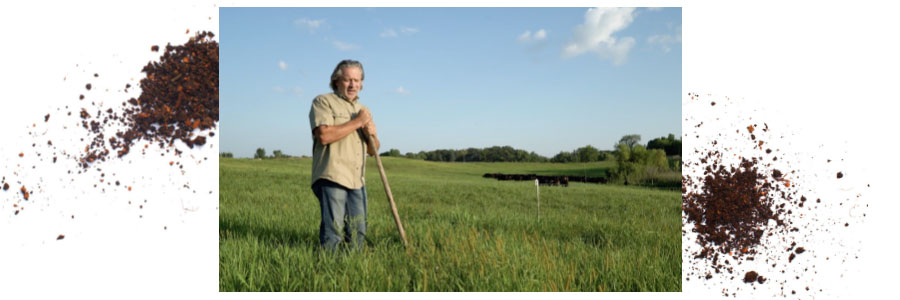


Sign-up for {N}power to get exclusive discounts, newsletters, members-only features, and more!
 Denver - Design District - Alameda and Broadway
Denver - Design District - Alameda and Broadway
368 S Broadway
Denver, CO 80209
United States
 Preferred Store:
Select a Store
Preferred Store:
Select a Store

In October 2018, the United Nations Intergovernmental Panel on Climate Change (IPCC) released a report sounding the alarm about the real effects of climate change to the planet. This team, made up of 91 scientists from more than 40 countries, scoured nearly every research paper ever written on climate change and came back with a battle cry: We need to act now.

Agricultural production is currently the planet’s largest form of land use, occupying about 40 percent of the earth’s land surface1 and is responsible for 25 percent of global greenhouse gas emissions, according to a 2019 report from the U.N. Environment Programme (UNEP).2 But according to the IPCC, agriculture is unique in its ability to both reduce greenhouse emissions, through sustainable farming practices, and capture them, helping reduce the amount of carbon dioxide (CO2) in the atmosphere. “The potential for carbon sequestration in soils via agriculture can play an important role in mitigating climate change,” the report points out. Some of the sustainable farming methods quoted in the IPCC report include reducing tillage, utilizing cover crops, planting perennial grasses, improving grazing management practices, and using manure and compost rather than synthetic fertilizers, all techniques that improve the soil’s ability to capture and hold CO2. While they are referred to as “sustainable” in the report, these are the very methods utilized by regenerative farmers and ranchers, taking us from a place of simply sustaining, to actively regenerating the land.3
Climate change looms as humanity’s greatest challenge, but a growing movement of farmers and ranchers are working to tackle the challenge through a set of practices called regenerative agriculture. Think of these farmers and ranchers as stewards of the soil. By using the techniques mentioned in the IPCC report, they are dedicated to improving the health of the land by restoring soil health—leaving it healthier at the end of each season, which allows it to sequester more CO2.
Project Drawdown, a global research organization that identifies, reviews, and analyzes the most viable solutions to climate change, ranks regenerative agriculture as one of the top actions we can take to reduce carbon emissions and save the planet.4 Scientists on the forefront of soil and carbon research say that restoring degraded soils worldwide has the potential to store 1 to 3 billion tons of carbon each year, equivalent to about 3.5 to 11 billion tons of CO2 emissions, with some scientists estimating it could store even more. (For perspective, in 2019 CO2 emissions from industrial activities and the burning of fossil fuels were at an all-time high of around 37 billion tons.)5 6 “Conventional wisdom has long held that the world cannot be fed without chemicals and synthetic fertilizers,” Project Drawdown states. “Evidence points to a new wisdom: The world cannot be fed unless the soil is fed.”
The chain of care begins right beneath our feet, in the soil. Healthy soil is teeming with life, including microbes and fungi that increase soil’s carbon storage abilities, and regenerative practices support that life.7 8 Healthy soil is able to absorb and retain rainwater, especially important during dry spells, and to prevent soil erosion during heavy rainfall. Healthy soil makes crops more resilient to extreme weather like droughts and helps farmland recover more quickly from extreme weather events. And healthy soil can act as a carbon sink, with the ability to sequester large amounts of CO2 from the atmosphere.9 10 11 12
Think of these farmers and ranchers as stewards of the soil.
Regenerative agriculture is not only good for the health of the soil and climate, it's also a win for animal welfare and family farms. Third-generation farmer April Wilson and her family have been raising hogs for more than 20 years in Iowa. Established in 1959 by her grandfather, Ernest Wilson, Seven W Farm is a perfect model for regenerative farming practices: The farm plants cover crops to build soil health, practices rotational grazing for their livestock, and utilizes tree buffer strips to reduce water runoff. The family is committed to diversifying what they grow and raise on their farm, which helps to support biodiversity, soil health, and farm resiliency. Wilson’s farm raises hogs for Niman Ranch,16 which supports the nation’s largest network of family farmers and ranchers, with more than 740 farms and growing. She credits them for understanding the hard work that goes into raising hogs in a pasture-based system with the highest standards in sustainability. “Investing in soil health and regenerating our soils has numerous benefits including water infiltration, reduced pest pressure, resilience to unpredictable weather, and reducing greenhouse gasses,” said Lauren Tucker, executive director of Kiss the Ground, a nonprofit organization that provides education and training for farmers and ranchers who want to adopt regenerative practices.17
As consumers, we hold power in our food choices. When you buy beef, buffalo, or lamb, look for 100% grassfed from producers who utilize managed rotational grazing practices, such as holistic land management; as for your dairy purchases, look for organic and/or 100% pasture based or 100% grassfed. With all other food choices, opt for organic, which also uses regenerative techniques that focus on building soil health. As we face the challenge of climate change, we can all do our part by supporting those farmers, ranchers, producers, and suppliers that are on the forefront of regenerating the future.



Sign-up for {N}power to get exclusive discounts, newsletters, members-only features, and more!
